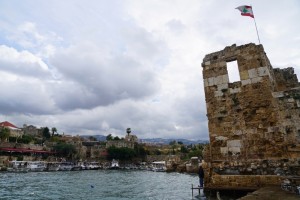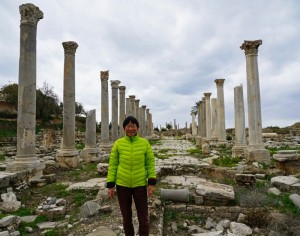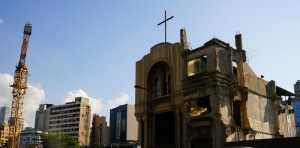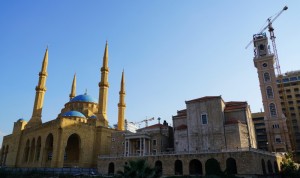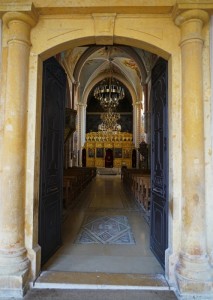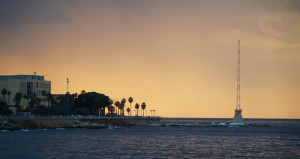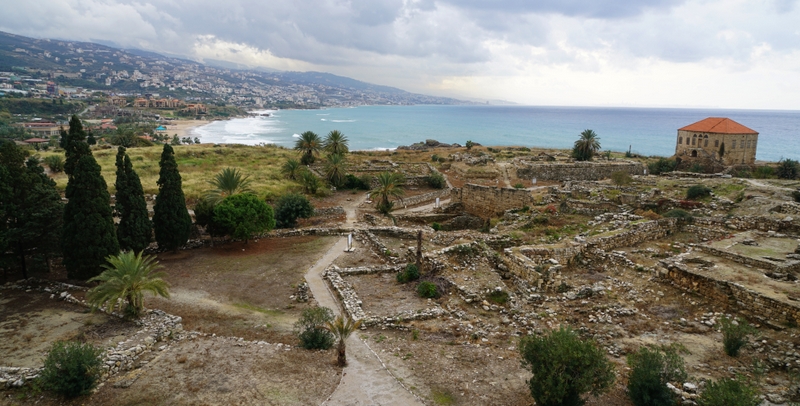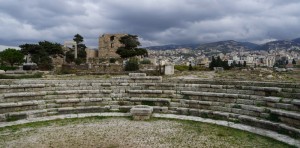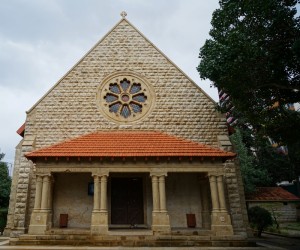December 29, 2015 – January 1, 2016: Beirut, Jeita, Harissa & Byblos
I have always been fascinated by Lebanon, home to a civilisation going back to around 3500 BC. Being one of the oldest countries in the world, it boasts a rich pre-Biblical history with five World Heritage Sites.
Lebanon officially the Lebanese Republic, though a small country with an area of 10,452 km², is the most liberal and free country in the Arab world.Bordering Syria to the north and east and Israel to the south, it has been at the crossroads of the Mediterranean Basin and the Arabian hinterland. Its location has facilitated its rich history, shaped a complex cultural identity of religious and ethnic diversity and had tumultuous periods. It boasts five cultural World Heritage Sites namely Anjar, Baalbak, Byblos, Ouadi Qadisha (Holy Valley) and the Forest of the Cedars of God and Tyre.
Brief History
![400px-Lebanon_region_map[1]](http://www.sarahontheroad.hk/wp-content/uploads/2015/12/400px-Lebanon_region_map1-241x300.png) The earliest evidence of civilisation in Lebanon dates back more than 7,000 years. Home of the Canaanites (also known as Phoenicians), the region emerged as a leading maritime power and had become part of numerous succeeding empires amongst them the Egyptian Empire, Assyrian Empire, Achaemenid Persian, Hellenistic, Roman, Armenian, Sasanid Persian, Eastern Roman, Arab (Umayyad, Addasid, Fatimid), Seljuk, Mamluk, the Crusader’s state of County of Tripoli founded by Raymond IV of Toulouse and the Ottoman Empire (1516-1918).
The earliest evidence of civilisation in Lebanon dates back more than 7,000 years. Home of the Canaanites (also known as Phoenicians), the region emerged as a leading maritime power and had become part of numerous succeeding empires amongst them the Egyptian Empire, Assyrian Empire, Achaemenid Persian, Hellenistic, Roman, Armenian, Sasanid Persian, Eastern Roman, Arab (Umayyad, Addasid, Fatimid), Seljuk, Mamluk, the Crusader’s state of County of Tripoli founded by Raymond IV of Toulouse and the Ottoman Empire (1516-1918).
While under the control of the Roman Empire, the region became one of the Empire’s leading centres of Christianity. In the Mount Lebanon range a monastic tradition known as the Maronite Church was established. During the Crusades, the Maronites re-established contact with the Roman Catholic Church and asserted their communion with Rome. During the 11th century, the Druze faith emerged from a branch of Shia Islam.
After WWI, five provinces constituting modern Lebanon were under the French Mandate. The French expanded the borders of the Mount Lebanon Governorate which was mostly populated by Maronites and Druze, to include more Muslims. Lebanon gained independence in 1943 establishing a unique political system – a consociationalism type of power sharing mechanism based on religious communities.
Civil War (1975-1990)
Lebanon has gone through alternating periods of political stability and turmoil interspersed with prosperity. In May 1948, Lebanon supported neighbouring Arab countries in a war against Israel. Some 100,000 Palestinians fled to Lebanon and Israel did not permit their return after the cease fire. Today, more than 400,000 Palestinian refugees still remain in limbo, about half in camps.
In 1958, an insurrection broke out instigated by Lebanese Muslims who wanted to make Lebanon a member of the United Arab Republic. United States dispatched 5,000 Marines to Beirut. Following the defeat of PLO in Jordan, many Palestinian militants relocated to Lebanon increasing their armed campaign against Israel. The relocation of Palestinian bases led to increasing sectarian tensions between Palestinians versus the Maronites and other Lebanese factions. A full scale civil war with a coalition of Christian groups against the joint forces of the PLO, left-wing Druze and Muslim militias finally broke out in 1975.
In 1976, Lebanese President Elias Sarkis requested for the Syrian Army to intervene on the side of the Christians and help restore peace. In October 1976 the Arab League agreed to establish a predominantly Syrian Arab Deterrent Force to restore calm. In 1982, the Palestinian Liberation Organisation (PLO) attacks from Lebanon on Israel led to an Israeli invasion and a multinational force of American, French and Italian contingents were deployed in Beirut after the Israeli siege of the city, to supervise the evacuation of the PLO. The multinational force withdrew in the spring of 1984. During this period, President Gemayel was assassinated and fighting, massacres and bomb attacks continued. In September 1988 the Parliament failed to elect a successor to President Gemayel and the Arab League Summit of May 1989 led to the formation of a Saudi-Moroccan-Algerian committee to solve the crisis.
On September 16 1989 the committee issued a peace plan which was accepted by all. A ceasefire was established and the ports and airports were re-opened and refugees began to return. In the same month the Lebanese Parliament agreed to the Taif Agreement which includes an outline timetable for Syrian withdrawal from Lebanon and a formula for the de-confessionalisation of the Lebanese political system.
The war ended at the end of 1990 resulting in massive loss of human life and property and ruining the economy. After suffering from armed conflicts since mid 1970s, almost the entire population has been affected in some way. It is estimated that 150,000 people were killed and 200,000 wounded. About 1 million civilians were displaced and some never returned. The end of the civil war has not brought peace: Lebanon continues to be beset by pressing political problems from within and its neighbours.
First, the Taif Agreement has still not been implemented in full and Lebanon’s political system continues to be divided along sectarian lines.
Second, Syria remained in occupation of Lebanon until 2005. It was forced only out following the Cedar Revolution which was a chain of demonstrations in the country triggered by the assassination of the former PM Rafik Hariri on February 14, 2005. Syria continues to a problem particularly since the Syrian Civil War broke out in 2011 with over 1 million refugees flee to Lebanon.
Third, the Hezbollah, a Lebanese Shia radical movement sponsored by Iran which gained prominence during the Civil War. It has refused to disarm and continued the tactic of capturing Israeli soldiers as leverage for a prisoner exchange. The capturing of two Israeli soldiers ignited the 2006 Lebanon War. Its ceasefire called for the disarmament of Hezbollah and the respecting of territorial integrity and sovereignty of Lebanon by Israel. The problem remains unsolved with both sides violating the ceasefire agreements: Israel by making frequent overflights over Lebanese territory, and Hezbollah by not disarming.
Fourth, the PLO had used Lebanon as the base for operations from late 1960s to 1982. The future of a Palestinian state is yet to be settled and the presence of 400,000 Palestinian refugees in Lebanon remains a strain on the country.
Economy
Lebanon, once prosperous and cosmopolitan, was compared to Switzerland and Beirut, its capital, was known as “the Paris of the Middle East”. The economy ruined during the civil war has gradually recovering only to be badly affected by the Syrian civil war lately. Capital investment to rebuild, renovate and improve the infrastructure is badly needed.
Despite the adversity, Lebanon thrives and maintains a competitive and free market and a strong laissez-faire commercial tradition. The economy is service-oriented and growth is driven by banking, commerce and tourism. There are no restrictions on foreign exchange or capital movement. It also benefits from its large, cohesive and entrepreneurial diaspora estimated to be 8-14 million with the majority living in Brazil. Remittances account for a fifth of the country’s economy. The 2014 estimate of GDP(PPP) and per capita (PPP) 2014 is $81.122 billion and $17,986. U.S. dollar is widely used alongside the Lebanese Pound at a fixed exchange rate of one dollar to 150 Lebanese pound (LBP).
Population & Diaspora
Lebanon is a multi-ethnic society. The population of Lebanese people is about 4.3 million (54% Muslim (27% Shia Islam and 27% Sunni Islam); 40.4% Christian (21% Maronite Catholic, 8% Greek Orthodox, 5% Melkite Catholic, 1% Protestant and 5.5% other Christian) and 5.6% Druze. In addition, there are some 400,000 Palestinian and 1.2 million Syrian refugees.
December 29: London, UK (GMT) – Beirut, Lebanon (GMT+2)
My plane arrived in Beirut on schedule after 9 pm. The airport is fairly modern, organised and efficient. I took a taxi for $30 and my hotel Bliss 3000 Studios in the Hamra district is about 15 minutes drive from the airport. The taxi driver was pleasant and asked me for a tip. Life is hard and I gave him $5. I had my first glimpse of this war-ridden city on the way to the hotel. The main road to the city is good. I saw many highrise buildings when the taxi went uphill to the hotel.
After check-in, I asked the receptionist to call Nakhel Tour Company to see whether I could join a tour to Cedars, Becharreh and Kozhaya the next day. Unfortunately, the tour was fully booked.
December 30 Wednesday: Beirut
My friends think I am crazy to visit Lebanon when the civil war is raging in Syria and IS is terrorising the world. Sam, a friend from the university kindly introduced me to his secondary school mate Matthew who taught in the American University of Beirut (AUB) before retirement three years ago. Matthew put me in touch with Abraham, his colleague who would meet me at the hotel lobby at noon.
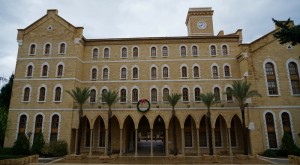 |
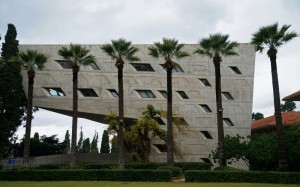 |
After breakfast, I spent two hours strolling along the Corniche along the windy Mediterranean coast next to Ain El Mreisseh. I enjoyed the sun and warm air while watching people jogging, fishing and sunbathing. The highrise buildings along the waterfront look expensive. (Later I learn each flat has an area of 300-500 square metres and some have a price tag of several million US dollars).
Matthew took me on a walk through the Hamra District, the commercial and business centre of Beirut with a high concentration of Christians before the civil war. The prominent presence of AUB, the oldest American University established in Middle East in 1866 occupying all the land between the Bliss Street and Ain El Mreisseh, somehow gives the area a cosmopolitan feel. Today, the area is still vibrant with banks, small shopping malls as well as local shops, hotels, cafes, bars, restaurants and several private hospitals.
We first walked along Bliss Street where he told me about AUB. The next stop was St. Mary Orthodox Church where Matthew had a quick chat with the priest. The Christian population has dropped drastically since the Civil War. Our third stop was a flower shop where Matthew introduced me to the owner who offered to drive me on Sunday for $125.
Then we arrived at Hamra Street before heading to his bank. I waited for him while watching the bank staff conducting their business: they look professional and efficient. I believe the high quality of the Lebanese people, their efficiency and resilience have enabled the country to survive!At 1 pm, Abraham took me to a minibus stop where I took Bus 4 to the downtown (1,000 LBP). Beirut is served primarily by private minibuses running on fixed route. I got off near the central business district which has been redeveloped since the end of the civil war. Not many old buildings remain. I saw a bombed church, a cinema and a few other buildings with many bullet marks. The area has been redeveloped into expensive high-rise condominiums, office buildings and high-end shopping malls.
I saw three young girls and a group of kids in front of the bombed cinema site. I had an enjoyable conversation with the girls who are secondary school students making a short film. Though they were all born after the war, they want people to stay positive and build the country together. I am moved and believe this country has a future as its young people are promising and forward looking.
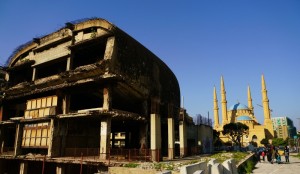
|
I spent three hours strolling in the area. I first went into the Greek Orthodox Cathedral of St George. The grand Mohammed Al-Amin Mosque looks impressive. As it was closed to visitor till 3 pm, I moved on without entering it. In the middle of the road is the Martyr’s Square and remains of Roman structures.
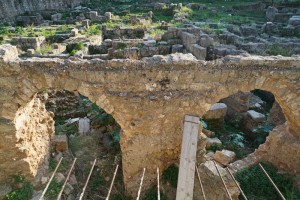 |
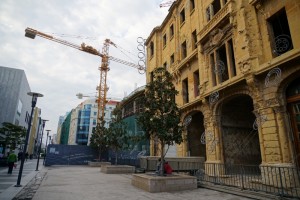 |
|
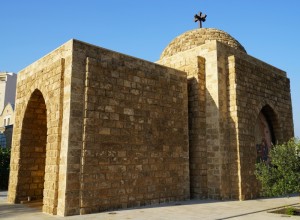 |
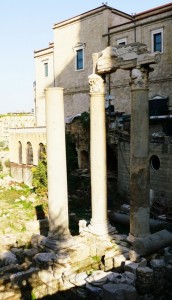 |
Next to the mosque is a huge hole/construction site. Then the whole area where the Parliament, Saint George Orthodox Cathedral, a Maronites Church, Place de Etoile, two mosques and a couple of hotels are located, is cordoned off with barb wire and heavily guarded. I asked the solider/police to let me in. He did and I visited the Orthodox Cathedral including the Crypt Museum (5,000 LBP) where history of the city for the last 2000 years can be traced. The whole area is not badly designed but it is sadly empty, souless and sterile. I asked the reason for restricting public access and got some vague answer. I gather the government does not want this prestige area be illegally occupied by protestors.
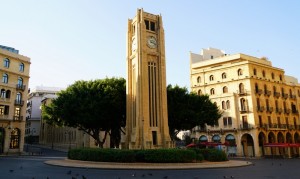 |
I walked to the Beirut Souks, a modern shopping mall with many window-shoppers. By 4 pm, I was hungry and tired. I went to a Lebanese restaurant by the seafront to watch sunset while having dinner.
By the time I came out, it was raining and dark. Without an umbrella, it would be impossible to walk back to the hotel. So I took Bus 15 (1,000 LBP) which runs along Ain El Mreisseh. The bus moved very slowly in order to pick up as more passengers.
New Year Eve December 31 Thursday: Jeita Grotto, Harissa & Byblos
Today, I joined a tour to Jeita Grotto, Harissa and Byblos ($85). I was picked up from the hotel together with Renee and Antonio from Miami at 7:45 am. After paying at Nakhal’s office, I set off with six tourists from Canada, Switzerland and the US.
First Stop- Jeita Grotto (18km north of Beirut)
On the way to the Grotto, we passed Nahr el-Kalb (Dog River), the estuary of which has a group of over 20 commemorative stelae with inscriptions and rock reliefs carved into the limestone rocks. These inscriptions serve to summarize Lebanon’s history with three Egytian hieroglyphic stelae from Pharaohs, six Cuneiform inscriptions from Neo-Assyrian and Neo-Babylonian kings, several stelae with Roman, Greek and Arabic inscriptions, a memorial to Napoleon III’s 1860 intervention in Lebanon and a dedication to the 1943 independence of Lebanon from France. These stelae have been listed in the UNESCO Memory of the World initiative since 2005.
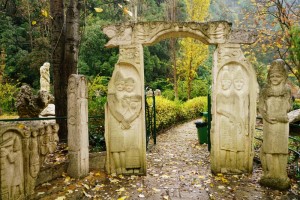 |
The grotto, a national symbol and a top tourist destination, is the source of the Dog River from which Beirut gets its water supply. Entrance fee is not cheap (18,150 LBP) as visitors have to take a cable car to the upper cave and a boat ride in the subterranean lake.
The grotto is a system of two separate but interconnected karstic limestone caves spanning an overall length of nearly 9km. The lower cave inhabited in prehistoric times was rediscovered in 1836 while the upper galleries 60m above the lower cave was discovered in 1958. I find the upper cave most impressive and beautiful with a well-designed walkway for about 700m and the world’s largest known stalactite (8.2m in high). The galleries are composed of the White Chamber, Red Chamber and the third and largest one which peaks at a height of 120m.
The lower gallery traversed by a smooth underwater river and a lake, has an overall length of 6.2km. We had an amazing but short cruise of 500m. I have been to many grotto. This one is indeed very special – a nature wonderland worth visiting. Unfortunately, no photography is allowed.
Second Stop: Harissa (20km north of Beirut)
We had a scenic ride to Harrisa, a mountain village located 650m above sea level, passing through some nice neighbourhoods. Harissa is home to Our Lady of Lebanon, an important Lebanese pilgrimage site as well as one of the most important shrines in the world honouring Virgin Mary. The shrine is highlighted by a huge, 15-ton bronze statue of the Immaculate Conception, Mother of God (8.5m high and a diameter of 5m). The Virgin Mary stretches her hands towards Beirut.
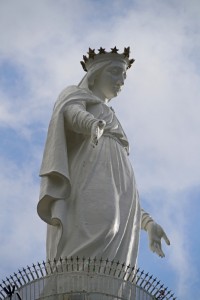 |
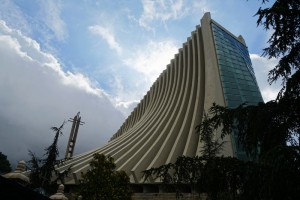 |
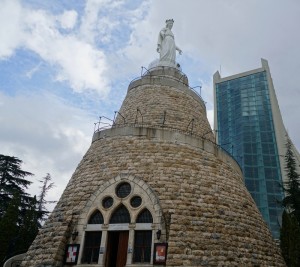 |
It was drizzling when we walked up to the platform below the statue. The rain stopped and the sun broke through the clouds for a while. We had good but not breathtaking views of Beirut and Jounieh. After having a 9-minute gondola lift down to the city of Jounieh, we re-boarded the van and proceeded to Byblos.
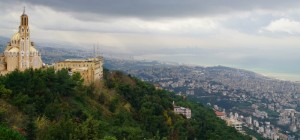 |
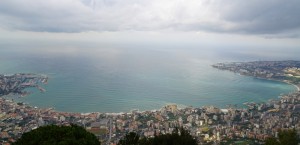 |
Third Stop: Byblos (35km north of Beirut)
Byblos (a World Heritage Site) inhabited since Neolithic times, is the site of multi-layered ruins of one of the most ancient cities in the world. It is a testimony to a history of uninterrupted construction from the first settlement by a community of fishermen dating back to 8000 years, through the first town buildings, the monumental temples of the Bronze Age, to the Persian fortifications, the Roman road, Byzantine churches, the Crusade citadel and the Medieval and Ottoman town. It is directly associated with the history of the diffusion of the Phoenician alphabet. According to legend, it was founded by the Cananean God El, son of Kronos. A neolothic village bears witness to the fact that the region was inhabited more than five thousand years ago while the ramparts of the Phoenician city, together with temples full of the old relics, date back three thousand years.
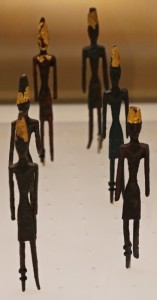 |
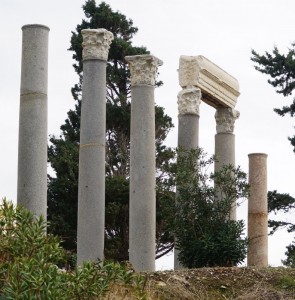 |
We had a brief stop at the ancient Phoenician harbour, a guided tour of the Crusaders’ Castle which houses a small museum and ruins of several thousand years including Roman arches, temples, roads, houses, burial sites and sarcophagus (the most famous one is now in the National Museum).
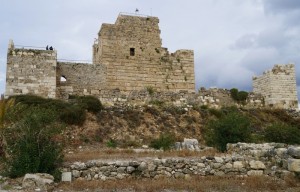 |
The guided tour was over around 1:30pm. Our guide took us to a restaurant in Jounieh before returning to Beirut. As the guide told me that the National Museum would be open till 5pm, I asked the driver to drop me off at the museum. It was 4pm when I found myself standing in front of a closed door. The guide was wrong and I had to find my way back. When I saw Bus 15 passing by, I jumped in. It’s an educational city tour by bus as it took me through many poor and old neighbourhoods north of downtown Beirut. I did not get off till 5pm!
Hospital Visit
When I got up in the morning, I found an unusual tiny lump in an obscure part of my body. To put my mind at ease, I decided to consult a doctor. There are three private hospitals in the Hamra district with AUB hospital being the largest and most established. It was about 5:30pm when I arrived. As all doctors had gone, I was advised to go to the emergency ward. The consultation fee is the same ($126).
AUB is modern, organised and efficient. I explained my concern to a young female doctor who in term called a skin specialist. I had to wait for an hour before a doctor in his late 30s turned up. After looking at the infected area, he assured me it was not a serious problem. He gave me a prescription and I got an anti-biotic cream 8,000 LBP from a nearby pharmacy. The whole process took about two hours. Another educational experience!
New Year Count-down
I have seen beautiful pictures of New Year fireworks over the Mohammed Al-Amin Mosque. As I was full after having a big lunch, I did not feel like eating. At 10 pm, I ignored the drizzle, left the hotel and walked towards the Mosque which is about 3km away.
By the time I arrived at downtown Beirut, many young people and families were already hanging out in the main street, cafes and pubs in and around the Beirut Souks. But no one could confirm the location of the fireworks. A guard in uniform told me to go to the waterfront while another pointed me in a different direction. I was confused. At the end, I followed a group of foreign workers to the waterfront.
It was raining heavily and was bitterly cold. When we got to the waterfront, we saw fireworks shooting up from the area around the Mosque. We hurried back and by the time we reached the Beirut Souks, it was close to midnight. I decided to stop at the Souks to join the crowd for the count-down. But things were disorganised: the fireworks did not work and there was a screen without count-down.
It’s the most bizarre New Year celebration: no cheer, no horn from cars; no fireworks…. But people around me looked happy and were in good moods! Feeling tired and disappointed, I took a taxi for $10 and went to sleep.
New Year 2016 January 1 Friday: Beirut
Originally, I planned to join a tour today. Unfortunately, no company runs tours on New Year Day. I thought of taking a taxi for a day. But I was not sure museums and places of interest would be open. At the end, I spent a leisure day wandering around.
First, I walked along Bliss Street and asked the guards at the AUB whether I could go in. He let me in and I had the campus to myself.
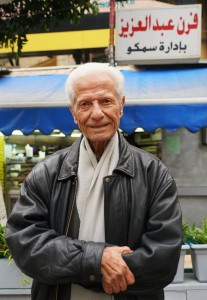 |
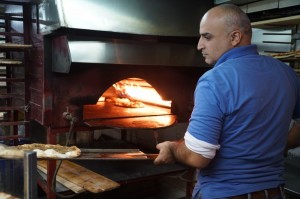 |
Next, I came across a local bakery with a few old men sitting outside. I had a local bread roll with cheese and beef for 2,500 LBP. It’s most delicious. Michael, one of the old men told me that this bakery is the best in Hamra. His family originally came from Yemen over two hundreds years ago and he is still living in the house built by his great grandfather opposite the bakery. He told me the area was farm land those days and he had witnessed changes over the years. He has retired and I was surprised when he told me he’s 90 years old and his father only passed away last year! He is healthy, alert and fit!
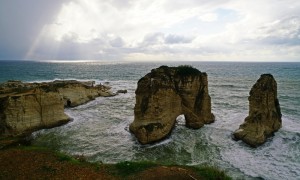 Then I walked to Raoucheh Corniche to see the Pigeons Rock, a landmark of Beirut. The weather was good but windy and cold. In order to enjoy the scenery, I had a cup of tea in the Grand Cafe (6,000 LBP) overlooking the coastline all the way to Sidon.
Then I walked to Raoucheh Corniche to see the Pigeons Rock, a landmark of Beirut. The weather was good but windy and cold. In order to enjoy the scenery, I had a cup of tea in the Grand Cafe (6,000 LBP) overlooking the coastline all the way to Sidon.
It started to rain when I walked back to my hotel. As it’s New Year Day, I treated myself with a light dinner at the atmospheric Cafe Hamra. I paid 3,700 LBP for a fish, fried rice, salad and a local beer.
When I was back in the hotel, the receptionist told me that the tour to Baalbak and Anjar the next day was cancelled owing to snow and road closure. I was disappointed when Renee and Antonio turned up. We decided to hire a taxi and go on our own. The receptionist found us a taxi driver who was prepared to take us to four attractions namely Tyre, Maghdouche, Beiteddin and Sidon, for $180 for ten hours.


